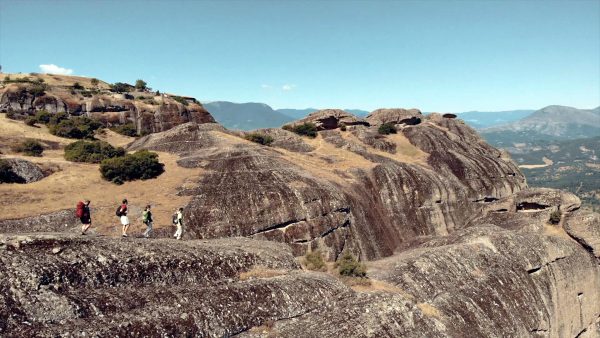Meteora is a geological and natural wonder, but at the same time, it’s a cradle of Orthodox Christian religious tradition. The giant dark rock formations that host a handful of venerable Orthodox monastic communities are unique in the world.
Meteora is a destination for all four seasons, rife with many paths, including one that is metaphorically a cycle of life in continuity.
Life here follows its own eternal path, from the primordial creation of the sheer stone rocks now visible high above the plain, ones created millions of years ago with the withdrawal of waters from the province of Thessaly, to the first ascetic monks who arrived in the 11th century, who were followed in the 14th century with the creation of the first formal monastic community by St. Athanasius in Meteorite and the subsequent building of the monasteries atop the imposing rock formations.
In the centuries that followed, amid periods of prosperity as well as decline, the Meteora region served as an ideal refuge for monasticism and the Orthodox faith, while at the same time preserving cultural monuments and priceless works of art. Pilgrims and travelers, of every age, have repeatedly described, with awe, the marvelous works of God and men at Meteora.
 Thirty monasteries have existed over the centuries on the rock formations, of which six operate today. Since 1988, in fact, they have been included on UNESCO’s list of World Heritage Sites.
Thirty monasteries have existed over the centuries on the rock formations, of which six operate today. Since 1988, in fact, they have been included on UNESCO’s list of World Heritage Sites.
Today thousands of visitors from around the world visit Meteora to admire the unique other-worldly landscape, to visit the monasteries and experience the sanctity of the location.
In the traditional settlement of Kastraki, at the ascent towards the rock formations, visitors will pass through a remarkable labyrinth of vegetation and natural imagery.
In the small but visitor-friendly city of Kalabaka, beneath the Meteora formations, you will find everything you need in its markets and old town quarter.
The taverns of Kastraki and Kalabaka feature local cuisine and traditional flavors prepared with passion, while visitors’ stay in hotels and traditional guesthouses, with a view of the formations, satisfy every need.
At the same time, Meteora is an excellent location for natural exploration and adventure, offering visitors unique experiences.
One of the best ways to get to know the stunning terrain of Meteora is through its footpaths and hiking trails. Old paths, once trekked by medieval monks, lead to incredible “hidden gems”. Visitors will discover passages, caves and hermitages in a unique natural environment, all in the shadow of the rock formations. The foot trail network in Meteora is well-marked marked and in very good condition, so anyone can walk the paths, even small children, especially with the assistance of a professional local guide.
 A similar and perhaps even more impressive experience is cycling around and atop Meteora, on absolutely safe cycling routes for everyone.
A similar and perhaps even more impressive experience is cycling around and atop Meteora, on absolutely safe cycling routes for everyone.
In Kalabaka you will find specialty shops renting bicycles, and professional guides for organized cycling tours. Electric e-bikes are also a favorite choice by families.
For the more daring adventurers, rock climbing on Meteora’s rock formations offers an experience of a lifetime. Here, in one of the most popular natural climbing challenges in the world, you will find climbing courses of varying difficulty, since, in addition to courses for experienced climbers, there are also ones for beginners who want to try a new challenge, but always under the guidance of experienced local alpine professionals.
If you still want something even more exhilarating, experience flying over Meteora with a para-glider or two-seater motorized glider. The view of the rock formations and monasteries from above and the feeling of absolute freedom while flying sends one’s adrenaline soaring. Experienced and certified pilots are your guides for such experiences.
At Meteora, every route is a unique image worth experiencing again and again. Whether as pilgrims to the monasteries, nature-lovers or extreme sports aficionados, explore with all your senses the thrill of a location that has no equal in the world.
For more information please visit the website of the Tourist Office of the Regional Unit of Trikala: elaMeteoraTrikala.com







































 Αριθμός Πιστοποίησης Μ.Η.Τ.232442
Αριθμός Πιστοποίησης Μ.Η.Τ.232442